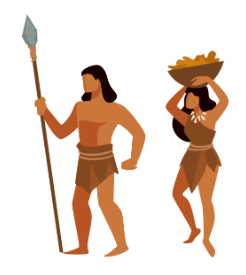From Hunting-Gathering to Growing Food Class 6 Worksheet History Chapter 2
Q1: Fill in the blanks.
(i) Millets have been found at ______.
(ii) People in Burzahom lived in ______ houses.
(iii) Chirand is a site in ______.
(iv) ______ and ______comes from animals that are reared.
(v) ______ is one of the earliest villages.

Q2: State True (T) or False (F).
(i) Jadeite, found in Daojali Hading, may have been brought from China.
(ii) Young women are respected for their wisdom and experience.
(iii) Mehrgarh site is in Pakistan.
(iv) Bolan Pass is one of the most important routes into India.
(v) Gufkral site is in Kashmir.
Very Short Answer type questions:
Q1: Which two Neolithic tools are used to grind grain even today?
Q2: Where people store the grains?
Q3: Name two sites found in Andhra Pradesh.
Q4: Which were the earliest animals to be domesticated?
Q5: Explain the term ‘Domestication’.
 Hunters
Hunters
Short Answer type questions:
Q1: Write a short note on Bolan Pass.
Q2: What was the purpose of the construction of pit houses?
Q3: What do you think would have been cooked in the jars by early man?
Q4: How was fire discovered?
Q5: Where did the Stone Age man live?
Q6: What is a burial?
Q7: What were the climatic conditions in the Neolithic period?
Q8: What types of tools did Neolithic people use to grind grain?
Q9: Why did early humans prefer to live near sources of water?
Q10: How did pit houses help people in Burzahom?
You can access the solutions to this worksheet here.
FAQs on From Hunting-Gathering to Growing Food Class 6 Worksheet History Chapter 2
| 1. What are the key differences between hunting-gathering and agriculture? |  |
| 2. How did the transition from hunting-gathering to agriculture occur? |  |
| 3. What were the advantages of agricultural societies compared to hunting-gathering societies? |  |
| 4. What were some challenges faced by early agricultural societies? |  |
| 5. How did the shift to agriculture impact social structures and communities? |  |






















